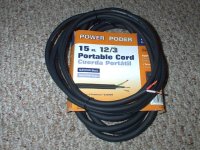EstebanUno
100 mW
- Joined
- Feb 23, 2011
- Messages
- 38
It's a really simple question, I know, but I'm new to electronics and haven't found an answer. Using 2 leads of turnigy 12awg silicone-insulated wire http://www.hobbyking.com/hobbyking/store/__9673__Turnigy_Pure_Silicone_Wire_12AWG_1mtr_RED.html, how do I bundle them together into a 5' long single cable?
Heat shrink the whole thing rather than just the connector ends? If so what size heat shrink tubing? Or ...
Is there a jacket that is commonly used for this? Maybe this wire mesh guard: http://www.hobbyking.com/hobbyking/store/__9554__Wire_Mesh_Guard_Black_10mm_1mtr_.html What size would be right for 2-12awg wires? It wouldn't scratch the bicycle frame would it? Or..
Spiral wrap like this. http://www.hobbyking.com/hobbyking/..._wrap_tube_ID_9mm_OD_10mm_Black_2_Metre_.html Not a very a clean look I would think? Again what size for 2-12 awg wires? Or ...
A better way?
A related question is what to use as a clamp to hold wires tightly to the battery bottle 15 mm exit hole? I'm not finding anything at Hobby King?
Thanks for the help - Esteban
Heat shrink the whole thing rather than just the connector ends? If so what size heat shrink tubing? Or ...
Is there a jacket that is commonly used for this? Maybe this wire mesh guard: http://www.hobbyking.com/hobbyking/store/__9554__Wire_Mesh_Guard_Black_10mm_1mtr_.html What size would be right for 2-12awg wires? It wouldn't scratch the bicycle frame would it? Or..
Spiral wrap like this. http://www.hobbyking.com/hobbyking/..._wrap_tube_ID_9mm_OD_10mm_Black_2_Metre_.html Not a very a clean look I would think? Again what size for 2-12 awg wires? Or ...
A better way?
A related question is what to use as a clamp to hold wires tightly to the battery bottle 15 mm exit hole? I'm not finding anything at Hobby King?
Thanks for the help - Esteban




